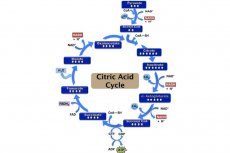

Decarboxylation occurs, releasing carbon dioxide out of the cycle. Furthermore NAD+ is used to form NADH. The formation of alpha-ketogluterate (a 5 carbon molecule) leads to another decarboxylation reaction and NADH is produced again in the presence of the alpha-ketogluterate dehydrogenase. Alpha-ketogluterate then forms succinyl-CoA (a 4 carbon molecule) which then becomes succinate (with succinyl-CoA synthetase) and GTP is created. Succinate is oxidised into fumerate as FADH (reduced flavin adenine dinucleotide) is produced in the presence of succinate dehydrogenase. Fumerate is converted into malate through the addition of a water molecule, which rearranges the bonds between the carbons. Malate then becomes oxaloacetate through oxidation with the assistance of malate dehydrogenase. NAD+ is reduced to NADH during the process. The cycle ends back where it started (oxaloacetate present) and the next cycle can take place.
One glucose molecule produces 2 acetyl groups, therefore for one glucose molecule the cycle happens twice. For every acetyl group that enters the cycle, two carbon dioxide molecules are released as waste products. The cycle removes electrons from acetyl CoA and uses them to reduce NAD and FAD into NADH and FADH.
The citric acid cycle links onwards the electron transport chain located in the inner mitochondrial membrane. The process is highly efficient as a limited number of citric acid cycle molecules can generate large amounts of NADH and FADH. NADH and FADH are then transferred to the electron transport chain where the transport of electrons is used to generate the energy needed for ATP synthesis. NADH and FADH are the carriers of these electrons. They release a proton (hydrogen) which splits into a hydrogen ion and electron. Electrons are transported down the electron transport chain, releasing energy as they move along, the energy is used to pump hydrogen ions across the membrane. This generates a proton gradient, which drives chemiosmosis. The movement of hydrogens via ATP synthase stimulates ATP production. Thus, the products of the citric acid cycle are used to generate more energy. Catabolic pathways are versatile as many organic molecules can fall into Glycolysis. Glycolysis accepts a range of carbohydrates, such as glycogen, starch and sucrose, as well as proteins and fatty acids. Fats are digested into glycerol and proteins are broken down into amino acids that can be fed into glycolysis.
The cycle is autocatalytic; one molecule of oxaloacetate can initiate the oxidation of an infinite amount of pyruvate. As the cycle is involved in both catabolic and anabolic processes, it is called an amphibolic pathway. The catabolism in the citric acid cycle of one glucose molecule contributes to the total 30-38 ATP molecules produced in the stages of respiration.
Acetyl-CoA, citrate, iso-citrate, alpha-ketogluterate, succinate, fumerate, malate and oxaloacetate are all intermediates that are regenerated during each turn of the cycle. Additional amounts of intermediate added can be retained within the cycle due to one intermediate being converted into another, thus the amount of intermediate increases. Withdrawal of intermediates for biosynthesis has the potential to cause damage. For example, if oxaloacetate is scarce, the cycle will stop.
image- https://www.thoughtco.com/citric-acid-cycle-373397

0 Comment:
Be the first one to comment on this article.